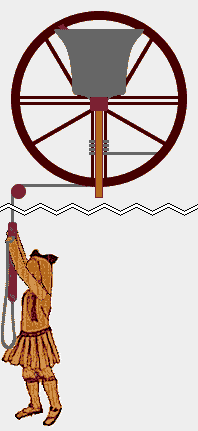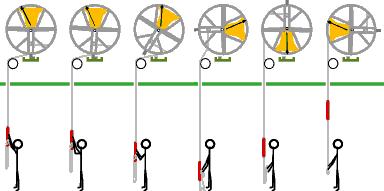Suggestions for improving striking
Holding the Rope’s End
When a bell is set at backstroke, reach up to the rope and take a relaxed grip on it – that is where you should hold it when ringing.
Adjacent to the set position is the balance. You should aim to pull the bell to the balance position each stroke.
If you take a grasp of the rope higher up, you will be stopping the bell from swinging full circle, and it will not get to the balance position.
You can overpull to keep the bell going round, but you will lose the rhythm on many strokes.
When the bell is set at backstroke, you can tell by reach where you should hold it, but when it is set at hand, your backstroke holding position is not so obvious.
If you are holding the rope in the right position, your pull will be much steadier because your weight is not affecting it. You should be able to hunt up to the back and over the back bells without chipping.
Standing Position
Stand so you can see the entire circle with both eyes. Keep your eyes looking horizontally right from the start. Don’t look up, down or to one side.
Ensure that the rope is hanging in the centre of the rope boss when you are holding it. If you stand too far back, your sally may catchon the boss or on the rope slapping board, and it will make a horrible noise.
Position of Hands
Keep hands together at both handstroke and backstroke. If the hands are parted, there is not much pulling being done by the lower hand.
Leading
Do not lead too quickly or too slowly at either hand or back. Listen during the opening rounds whether the band wishes you to be quicker or slower.
Odd struckness
About 90% of bells are oddstruck. There are four types of oddstruckness:
- Slow at hand, quick at back
- Quick at hand, slow at back
- Quick both ways
- Slow both ways.
You counteract the oddstruckness by your pull – eg. pull a bit more at handstroke to hurry the handstroke along and you can then ease the backstroke off.
Hearing Your Bell
Many ringers cannot "hear" their bell, or the other bells. So do not be shy at asking advice – it is better to ask than for you to be always (or sometimes) out of place.
Ringing the Tenor
Many ringers think that ringing the tenor behind is easy, but it should be setting the rhythm, so think about:
a, Ring as close as possible to the small bells when they are at the back,
b, Ease gently off the big bells,
c, When small bells are at the back, the back bells are often at the front. If the tenor is not close over the small bells, it makes hard work for the heavier bells.
Ringing The Other Bells
Front bells over each other should be reasonably close.
Back bells over each other should be slightly eased off.
Small bells dodging with back bells should try to be nicely in place under the back bell, so that he can reciprocate and make it reasonably easy for both.
Going wrong - being put right
Remember the slogan “Jump to it!” Even if you think you are right, please do as advised. Fill a hole and avoid a pile up. The ringing may have been super, so try and help keep it that way. There might be two bells over at the end – so what!! Remember, ringing is instantaneous. The conductor must shout quickly and loudly to get the message across. This does not mean he is cross with you! He just wants to avoid an awful noise, so don’t get upset about it.
Between Touches
As soon as a band takes hold, please cease laughing, joking and talking. The treble will be waiting to call “Look to”.
Rhythm ring
Count the bells round. This gives you your place and rhythm position.
Ringing Up and Down
All bells are of importance. The third and fourth often get out. If three or four are in front of the second, pull a wee bit more. If wide, ease in a bit. Do not forget, the back bells are depending on you.
Every touch is a performance
The general public cannot tell whether you are practicing or performing. Thus, every time you ring, you should think of it as a performance.

